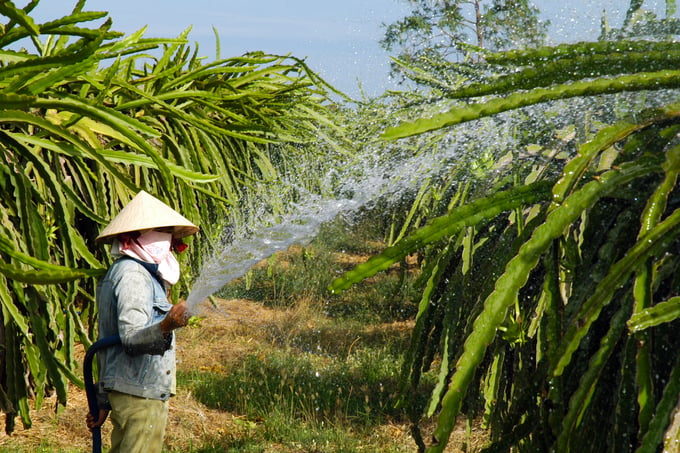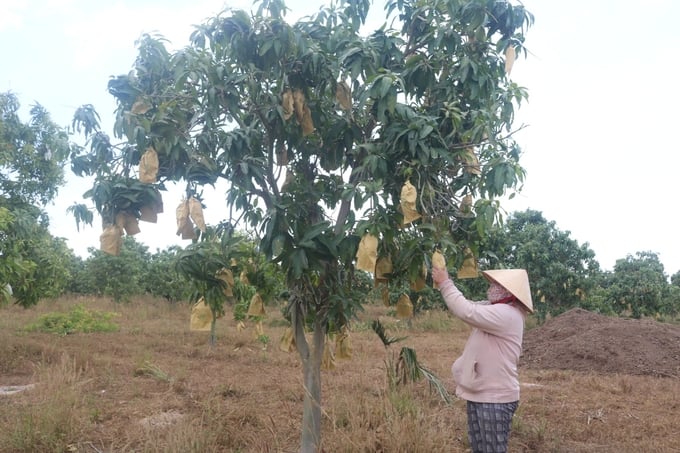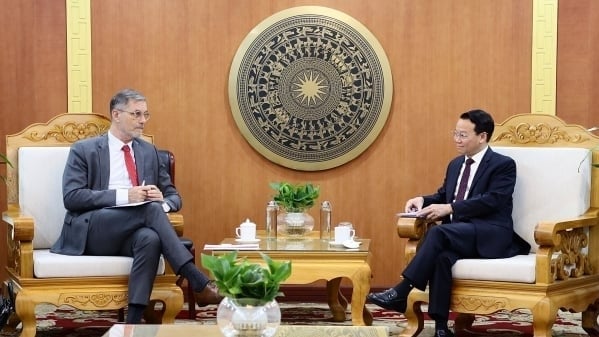May 22, 2025 | 12:04 GMT +7
May 22, 2025 | 12:04 GMT +7
Hotline: 0913.378.918
May 22, 2025 | 12:04 GMT +7
Hotline: 0913.378.918
Along with Ninh Thuan province, Binh Thuan is located in the driest region in the country. The dry season usually starts from November to April next year. But the rainy season only lasts 3 months, including August, September, and October. Therefore, it can be said that the dry season in Binh Thuan often lasts long, leading to the depletion of surface water in rivers and natural streams and impaired groundwater.

El Nino returns, dry provinces like Binh Thuan are very disadvantageous in supplying water for production and domestic use. Photo: KS.
Binh Thuan province currently has 49 irrigation reservoirs of all kinds being exploited and used. The total design capacity is just over 362 million m3. Still, the province's total water demand for daily life and agricultural production from now to 2030 is more than 1,169 million m3 per year. Thus, it has not met the requirement of storing water to supply water for domestic use and agricultural production in the dry season months.
The current concern of Binh Thuan province is that the influence of El Nino often causes a shortage of rainfall in most regions of the country, commonly from 25 to 50%.
In addition, some meteorological agencies in the world, such as the World Meteorological Organization - WMO, the US Climate Prediction Center - NOAA, and the Japan Meteorological Agency - JMA have jointly stated that El Nino will appear from the mid-months of 2023.

Although affected by El Nino, Binh Thuan province is trying to supply domestic water for people. Photo: KS.
Nguyen Huu Phuoc, Deputy Director of Binh Thuan Department of Agriculture and Rural Development, said it would be highly disadvantageous to Binh Thuan province to ensure water sources for daily life and agricultural production. Because in recent years, when El Nino appeared, it greatly affected people's everyday life and agricultural production.
Typically, in 2014, tens of thousands of households were without water in Tuy Phong, Bac Binh, Ham Thuan Bac, Ham Tan, and La Gi districts. For producing countries, the whole province had to cut back 17,600 ha of crop production in the winter-spring and summer-autumn crops due to a lack of water sources.
According to Nguyen Huu Phuoc, to cope with the return of El Nino and ensure water sources for daily life, agricultural production, and other economic sectors, the local agricultural industry has advised the Provincial People's Committee to have a The document direct relevant departments, agencies, agencies, units, and local authorities in districts, towns, and cities to implement solutions to cope with the risk of drought, water shortage and saltwater intrusion as directed by the Prime Minister and the Ministry of Agriculture and Rural Development.

Many lakes in Binh Thuan are inert when affected by El Nino. Photo: KS.
Accordingly, in terms of solutions and immediate scenarios to cope with the return of El Nino, the Provincial People's Committee asked localities to strengthen propaganda to inform people about the current water shortage in irrigation reservoirs and hydropower in the province. As well as giving warnings about the high probability of El Nino phenomenon in 2023 and 2024, the risk of heat, drought, and severe water shortage in the upcoming time.
In addition, the Provincial People's Committee asked localities to develop plans to prevent and combat drought, lack of water for daily life, and overall production from 2023 to 2025. Solutions to cope with other scenarios There are differences in meteorology, hydrology, and water resources due to the influence of El Nino, including the case of El Nino with a substantial and long-lasting impact as occurred in the years 2014, 2016 in the locality.

Binh Thuan province has now prepared a plan to respond to the return of El Nino to ensure production for the people. Photo: KS.
Along with that, guiding people to proactively implement measures to store water, including building water tanks, digging ponds and wells, and building temporary dams on rivers and streams for daily life, livestock, and irrigation for dry crops, has high economic value; install field pumping stations to maximize surface water resources; to use efficiently and save water and electricity; to prevent loss and waste to proactively respond to the risk of drought and prolonged water shortage.
In the long term, to cope with drought, the Department of Agriculture and Rural Development recommends central ministries and branches pay attention to support Binh Thuan province with funds to invest in large water reservoirs as planned, such as La Nga 3 Lake with a storing capacity of over 400 million m3 of water, upgrading and repairing irrigation reservoirs that are currently damaged and seriously degraded. The rest have not yet been invested in storing reserve water for daily life and production. Also, pay attention to support investment in increasing the plant's capacity and expanding the network of water supply pipes in the concentrated water supply systems in rural areas currently being exploited and used in the province.
According to the Binh Thuan Department of Agriculture and Rural Development, in the face of drought risk due to El Nino impacts and the shortage of water sources in the current irrigation works systems, the Department noted that localities should focus on reviewing, identifying, and warning areas with active water resources, places at high risk of drought, water shortage, and saltwater intrusion to direct the arrangement of production to suit the capacity of water sources. Also, proactively adjust the crop, suitable crop structure, and convert the rice area in drought-stricken areas and areas where water sources are not guaranteed to dry crop cultivation using less water for irrigation, in line with market demand.
Translated by Ha Phuc
![Reducing emissions from rice fields: [3] New values generated from carbon credit](https://t.ex-cdn.com/nongnghiepmoitruong.vn/608w/files/content/2025/05/19/dsc09613-144700_71-150957.jpg)
(VAN) In addition to helping safeguard the environment, the low-emission rice cultivation model also generates new opportunities for farmers by leveraging the carbon credit market.
![Ho Chi Minh city adapts to climate change: [1] Vulnerable in the whirlwind of development](https://t.ex-cdn.com/nongnghiepmoitruong.vn/608w/files/duyenht92/2025/05/19/3131-ngap-nongnghiep-163121.jpg)
(VAN) As the country's economic engine with a rapid urbanization rate, Ho Chi Minh city is facing increasingly serious consequences of climate change.

(VAN) On May 21, Minister of Agriculture and Environment Do Duc Duy worked with Mr. Olivier Brochet, Ambassador Extraordinary and Plenipotentiary of the French Republic to Vietnam.

(VAN) VRG recently conducted a visit and working trip to the United States to demonstrate its efforts in redefining the role of rubber enterprises in the global value chain.

(VAN) In 2024, over 295 million people across 53 countries and territories faced acute hunger—an increase of almost 14 million people compared to 2023, while the number of people facing catastrophic levels of hunger reached a record high.

(VAN) World Environment Day 2025 (June 5) carries the theme 'Beat Plastic Pollution' continuing to emphasize the global urgency of addressing the plastic waste crisis.

(VAN) This was the assessment shared by experts at the workshop titled 'Assessing the Role and Potential of Low-Emission Rice Production Systems in Vietnam,' held on the morning of May 19.